Shamelessly copied from my blog: https://syonyk.blogspot.com/2019/07/i-bought-used-chevy-volt-and-you-should-too.html
I give myself permission to use my work in this way.
For those who don't live in a place where a short range BEV is a valid option - consider a used Volt! It can do everything, though if you don't have any charging capability, don't buy a Volt.
=============
Some while back, I tossed in a (little noticed) comment at the end of a post that we'd obtained a Chevy Volt. We picked up a used 2012 Volt with under 30k miles, and have been using it quite a bit, because, well, it's our car.
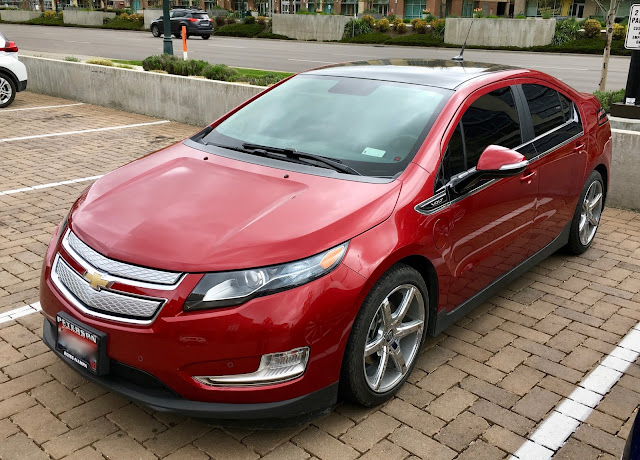
Since it's my blog and I can post what I want, I've decided to talk about the Volt for a while. I think it's the "sweet spot" for electric transportation at this point in time, I think it's rather significantly more environmentally friendly than a pure BEV for most use cases, and I think that, for most people, it's a really, really good car and highly worth considering if you're interested in cheap, (slightly) environmentally friendly car transportation. Plus, they depreciate like mad (just like all other electric cars), so you can get one cheaper than you might think!
The Chevy Volt
If you're not familiar with the Volt, you may be in the process of confusing it with the Bolt - which is also a Chevy product. And some marketing people at Chevy should be strung up for that bit of cutesy confusion, because it doesn't help anyone. It's confusion for the sake of confusion as far as I'm concerned.
The Bolt is a pure electric car (EV). The Volt, on the other hand, is a "plug in hybrid," a "series hybrid," a "range extended electric vehicle," or... probably half a dozen terms I've seen over the years. It's somewhere between a pure electric car and a hybrid - but, in reality, it's far better than either!
The Gen 1 Volt (2011-2015) has a 30-40 mile battery only range in the summer - plus a decent little gasoline engine and a useful gas tank (9 gallons) that can run it down the highway pretty much as long as you can find a gas station every few hundred miles. The Gen 2 (2016-2019) upgrades to about a 50 mile battery only range, a larger gas engine, and a different transmission design, but works out to the same thing - some battery range and then a gasoline engine for longer travel.
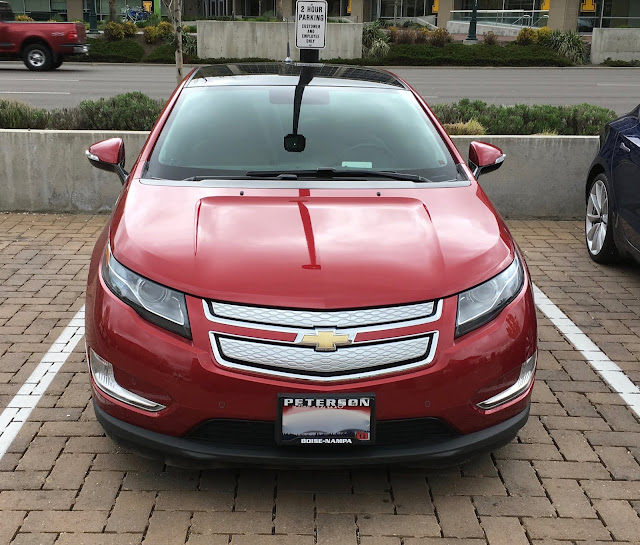
This means that you plug the car in at night (or during the day) to charge the main battery. When you set off, you run in a pure electric mode for the battery range - 20-60 miles, depending on which version you have and the outside temperature. Once the battery runs out, the gas motor kicks on, and you can drive it across the country on gas. Or, more commonly, make it home without having to find somewhere to charge.
But, on the flip side, it uses a far smaller battery pack than pure battery electrics - and it makes far better use of that pack!
BEV, PHEV, Hybrid, ICE... Oh My!
If you're familiar with electric vehicles, hybrids, and such, you can just skip this section.
If not, I'll explain a few of the various terms in common use you might run across, and what they mean.
We'll start with what everyone is familiar with: ICE. That means "Internal Combustion Engine." It refers to pretty much every vehicle that doesn't have a battery pack for propulsion (a "traction battery"). The phrase "Getting ICE'd" does not mean getting killed, in the context of electric vehicles. It means someone with a non-electric vehicle parking in a charging station. Don't do that.
Presumably, if you're the type of person who thinks a steam car is genuinely cool, you might hear the term ECE - External Combustion Engine. As someone who thinks steam cars are awesome and yet doesn't own one, well... I've not actually run across this term. But you might!
A "Hybrid" is a car that uses both a gasoline engine and a battery pack for propulsion - and doesn't allow you a way to recharge that pack (from the factory - I know people have added external charges to some of them). The Honda Insight and Toyota Prius are the most commonly seen versions of this sort of vehicle. When you decelerate, the car can recover the kinetic energy into a battery pack, and can use that energy to accelerate away from a stoplight. It improves fuel economy, and the Prius, in particular, uses some creative valve timing on the gasoline engine to improve efficiency more, at the cost of power production. A typical hybrid has a battery pack in the 1kWh range. It's not designed to propel the car down the road for long, just to store braking energy and use it for acceleration (though some will allow use for a bit of low speed driving).

Beyond that, you have PHEVs - Plugin Hybrid Electric Vehicles. The Volt sits in this category, as do things like the BMW i3 with the range extender, the Chrysler Pacifica minivan, the Prius Prime, and scattered other vehicles. This is similar to a hybrid, except that it has a far larger battery pack - and, importantly, a charge port. Most PHEVs have a battery pack in the 10-15kWh range, which means they can drive 30-50 miles on battery. Beyond that, there's a gasoline engine that kicks in and allows you to drive until the gas tank is empty. Details vary wildly - the BMW i3 has a tiny little peanut gas tank and a scooter engine for the range extender. The Gen 1 Volt has a smaller gasoline engine than the electric motor, which means mountains can be tricky (if you don't use "mountain mode" for hard climbs). The Gen 2 Volt has a large enough gas engine to run the whole vehicle on gas. The plug in Prius is similar. And, for what it's worth, I'd consider electric bikes to fit in here as well - you can still ride with the pedals if the battery pack is drained!
Finally, at the far end, you have BEVs - Battery Electric Vehicles, or just EVs. There's no gas motor anywhere in these cars. Just a large battery pack, an electric motor, and... well, that's it. If you're out of battery pack charge, push. Or hope you're on a mountain top and can use regenerative braking on the way down. This includes all the Teslas, the Nissan Leaf, the Chevy Bolt, and quite a few others.
Average Daily Driving Distances
At this point, I'm going to delve off into the weeds of statistics - and if your first thought isn't "How to lie and cheat with..." - well, let's just say that most statistics are calculated for a purpose.
Here, I'm going to quote an AAA study - "On average, Americans drive 29.2 miles per day, making two trips with an average total duration of 46 minutes." This is, of course, an average, and averages are mostly worthless, but it scopes the problem somewhat. The Office of Highway Policy Information has some data from 2009 (a bit dated, but still useful) that shows trip mileage and total miles driven by trip length.
While the vast majority of trips (by trip start count) are short, if you look at the mileage by trip length, the total mileage pie is more evenly split. This makes sense - longer trips, sort of by definition, chew up more miles than shorter trips!
Also, you should be horrified that 10% of car trips are less than 1 mile. Walk! Bike!
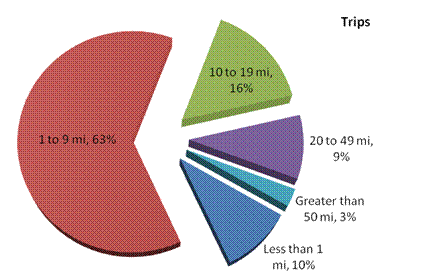
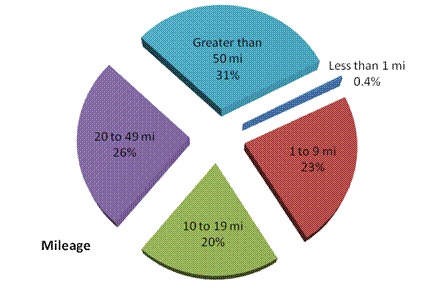
But the reality is that long distance driving is the minority of trips for most people. People still make long trips (greater than 50 miles is 3% of trip starts), and it's a use case that has to be handled, but it's not the typical daily trip for most people.
The "common case" is a short trip (less than 20 miles) - and the Volt handles those perfectly on electric.
Battery Packs, Embodied Energy, and Longevity
There is no battery fairy that waves a magic wand and blinks batteries into existence. Batteries require raw materials and quite a bit of energy to produce, and those have to come from somewhere. Lithium batteries, in particular, take a lot of energy to produce, and battery production is still quite limited globally (compared to global energy use, or even transportation energy use). This means we should be using batteries as efficiently as possible (while production constrained - and, I'd argue, for the long term as well to improve resource utilization) - and long range BEVs don't do that at all.
If you assume that people want one car to cover all their needs (from driving to the store next door, apparently, to driving across the country), that car needs a long useful range. For a gas powered car, this is no problem - we have a network of liquid fuel stations to refill from. For a battery powered car, making this work requires a rather large battery pack, and a network of fast charging stations. Tesla covers this use case decently (depending on where you want to go), but it means their cars have far more battery than is needed for most daily trips. A 100kWh Tesla can drive over 300 miles on a charge. When average daily driving trips are only 30 miles, this means the car has 10x the battery required for regular daily trips. I did some math a few years ago and estimated that the energy to produce a Tesla battery (before you ever use it) would power about a lifetime of electric bike use (https://syonyk.blogspot.com/2015/11/how-far-can-you-ride-electric-bike-on.html). The numbers are almost certainly better now, but there's still a lot of energy that goes into building battery packs that don't get heavily utilized.
Another concern is battery longevity. Cell phone batteries die inside a few years - why don't car batteries do the same? With a few exceptions (the Leaf's air cooled pack), EVs do a great job of managing their battery pack. They keep them cool in the summer, warm in the winter, and don't charge them fully. Not fully charging a cell really helps improve the longevity, and the data from most (not-Leaf) EVs shows that range loss just isn't that large a problem.
But what happens if you pick a far less battery intensive solution? That's what Chevy did, and it works really, really well!
Smaller Packs With a Backup
What Chevy has done in the Volt is to use a smaller pack (16kWh in the Gen 1), take good care of it, and use the middle 85% or so. The Volt pack is never fully charged according to the cell chemistry. It doesn't charge past 384V for the 96S pack, or 4.00 V/cell. You can pull 10-11kWh out of the Gen 1 pack before it's "empty" according to the car, but there's still a few kWh left at the bottom. The Volt uses this capacity to help with acceleration, to allow the engine to shut down at stoplights, and generally acts like a standard hybrid, even with "zero" battery range left.
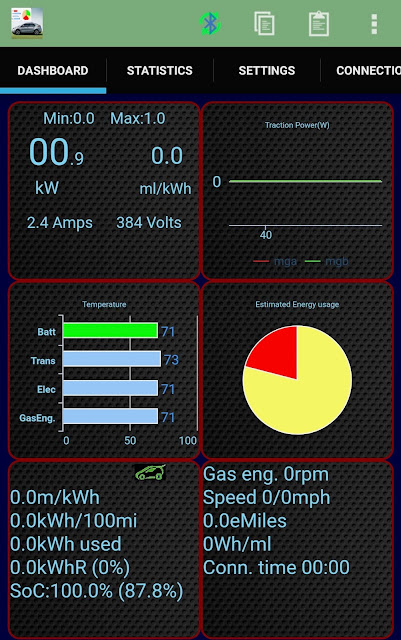
If you do the math, the cells that would go into a single 100kWh Tesla can build over 5 Volt packs. Those packs can be run conservatively for an incredibly long life, and those cells will offset far, far more gasoline use in 5 Volt-type vehicles than they would in a single long range EV.
Yes, you run out of battery range more regularly, but since there's a gas engine that kicks in, it just doesn't matter. The transition in the Volt is seamless, and if it weren't for the dashboard showing that the mode had switched, I wouldn't know most of the time.
If you assume 5 Volts can do 30 miles a day on battery, that's 150 miles of electric range from those cars - every single day. Putting them all in one car (as you would with a long range BEV) would only replace a small fraction of that gas use (for most people). They're just carrying the cells for those occasional long distance drives that the Volt uses gas for.
Plus, with a normal EV, people never run the pack to empty. The car would stop moving if you do that. With the Volt? Running it "to empty" is just a normal part of operation, and the motor takes over to get you home. So you can regularly use that 10kWh of capacity and not worry about range - there is no concept of range anxiety.
"Empty" (no EV range remaining) works out to around 329V for the pack - or about 3.4V/cell. There's a bit of capacity left that the pack might use for various reasons, but the Volt really is gentle on the cells. A normal lithium cycle would be 4.2V fully charged to about 2.5V empty (or 3.0V if you care about longevity at least a tiny bit). The Volt cycles the cells from 4.0V to 3.4V - and that's squarely in the middle of their range, so they're not stressed at either end. It's an insanely conservative solution, but the pack longevity isn't a problem at all! Plus, the pack is thermally managed. Even on a 95F day, the pack is 78F when getting home. It's heated in the winter, cooled in the summer, and doesn't see extreme temperatures. The car will use energy to heat/cool the pack when plugged in, so keeping the car plugged in whenever possible helps longevity as well.
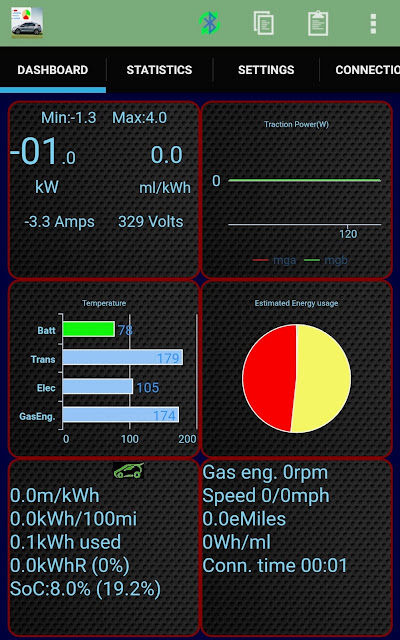
Numbers: A Year of Efficiency
As much as it might surprise people, I'm not keeping detailed statistics on the Volt. I don't like cloud services, so I'm not using the OnStar service (which is going away soon anyway - the Volt's cell modem only talks to towers that are getting shut down), and I haven't bothered to put local logging in. It's mostly my wife's car, and knowing detailed numbers doesn't really change anything - it's going to operate how it operates, and I'm not about to ask her to do things like turn the heat off (with kids in the back) to save a nickel in fuel on a trip.
We got the Volt to cover our common case trips on battery. They're typically 20-30 miles a day, round trip, into one of the nearby towns. We might do this multiple times on some days, but frequently it's one major trip. This is mostly on 45-55mph rural roads in a grid.
We've found that the Volt gets a pretty reliable 35 miles of battery range in the warmer weather. The air conditioning doesn't really impact the range a noticeable amount for our driving. However, in the winter, the battery range is far worse - sometimes as low as 20 miles. The whole car gets far less efficient in the winter (gas cars do as well, you just don't typically notice), and the car will use a ton of energy to heat both the car and the battery pack. If you've been driving long enough, things warm up, but that takes a lot of energy - and so the gas motor turns a lot more in the winter.
Of course, you can do better in certain conditions. If you're, say, following a bunch of antique cars around at 30-35mph, without HVAC, and there's a bit of a downgrade at the start of the trip, my personal best in a Gen 1 Volt is 53.3 miles on battery.
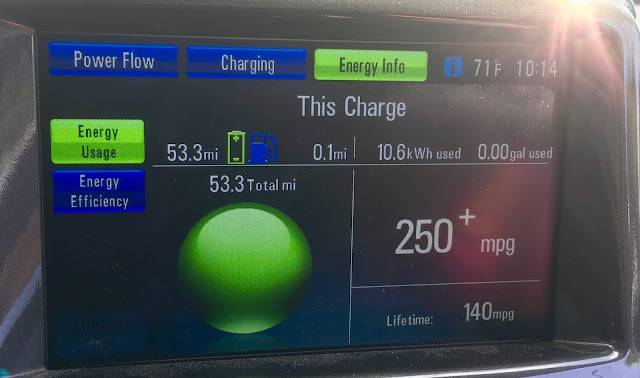
If it's cold enough, the Volt will run the gas engine for cabin heat. The car will get some electrical energy out of this, but mostly, the goal is hot coolant to cycle to the heater core. There are hacks to bypass this behavior, but for our driving distances, we'll use the engine at some point on a town trip in the winter, so I haven't bothered bypassing it.
On battery, the Volt will get 2-3.5 mi/kWh - you can get it slightly higher, but not by much (and it typically involves descending terrain). On the gas motor, fuel economy, warmed up, on the highway... is about 33mpg. I know it's rated higher, but this is what we get on standard E10 premium with a warmed up engine, doing 75mph (in other words, refueling during a highway run). Gas miles are consistently in the 30-35mpg range for any length travel, though they're worse in the winter when the engine block is cold.
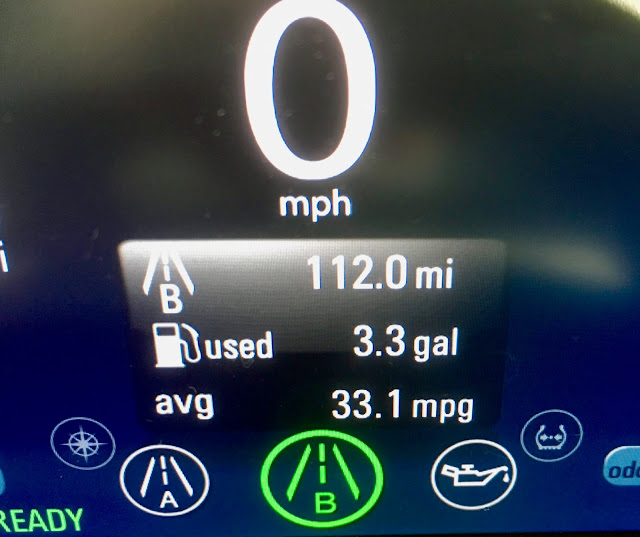
It's not great - but it's also not terrible for a good sized four door car loaded down with four people and luggage, running on pure gas. Yeah, a Prius will do better - but running purely on gas is not at all the intended use case for a Volt!
More typically, we see 300-400 miles per gallon of gas used (in the warmer weather). The gas is used for days with multiple trips into town that exceed our charging capability, and for longer round trips (some of the places we go on occasion are 50-60 miles around - that's a gas day). Even on the longer trips, though, it's rare to drop below 70-80 miles per gallon of gas used - the 35 miles on electric really help bring the total up.
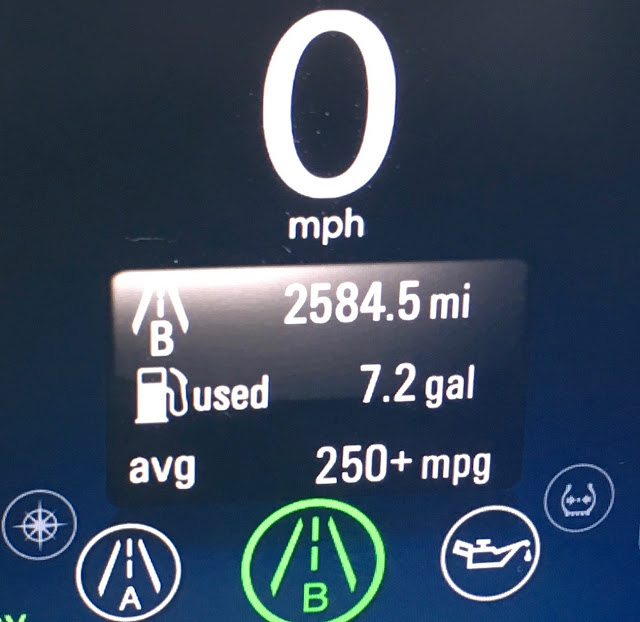
Charging: Yeah, 120V is Fine!
All of these numbers above? They're charging on 120V. It takes us 9-10 hours to charge the car from empty, and that means that mid-day charging almost never makes up the total used. If the car makes an early morning trip, it might be charged by the afternoon, but typically? Our evening trips start out half-charged. Sometimes I can top off in town, usually not.
I'll eventually add 240V charging to the property, but for nearly the last year, we've charged on 120V - and it still works fine. Even on nights when the car comes back late, it's still charged by the morning. If I had 240V charging, the car would be charged from empty in a hair over 3 hours - which would mean our evening trips were always starting with full battery. That would offset a good bit of our gas use - especially in the winter, when the battery spends a lot of energy producing heat.
One downside of 120V charging is that the preheat mode (when you suggest to the car that it might want to warm up with grid power) doesn't really save much energy - most of the energy for heating the systems comes from the battery, and though the car can use 5kW heating, it only gets 1.4kW from the wall. A 240V charger will help a lot on that front.
Volting About the Mountains: Antique Car Meets
I've talked about antique cars in the past (https://syonyk.blogspot.com/2017/09/driving-1927-willys-knight.html). This year, we went to a meet, but took the Volt. It's not antique, but it is well suited to hauling a 1 year old boy around - several experiments demonstrated that he wasn't able to sit by himself in the back of an older car, and that he wasn't at all happy with his car seat back there. We'll try again for an old car next year - but this year, I got a chance to run around some back roads and mountains around Pendleton with the Volt. It's the first time I've had a chance to really play around with the car in the mountains and on twisty roads - and it's an awful lot of fun!
One of the things you might run into (that drives some Volt owners nuts) is that the Volt's accounting of power to battery vs gas motor can feel a bit inaccurate at times. The car is either in battery mode or gas engine mode - and it won't swap back from the gas mode until the battery is sufficiently charged. Even if you charge for an hour or so on 120V during a trip, the car will still consider things in gas mode - even as it runs off the stored charge.
For this particular day, we started off by heading up a winding mountain road, then driving around up on top. The battery range is fairly poor because it was a hard climb up - but I was able to charge up on top. Even though the car never switched back from gas mode to electric mode, I got an extra kWh shown in the battery power used statistic. Then, coming down the mountain, I was able to regenerate about 2kWh into the pack (I had to check with a separate monitoring device - the car won't show this), and run around at the bottom of the mountain purely on electrons - even in "gas" mode.
This worked out to a gas "miles per gallon" of 64mpg - even though the car gets nowhere near this in reality. It's just a quirk of how the accounting system keeps track of things. Again, some people get annoyed by this, and I just don't care, because it's busy not using gas (and I'm not really keeping track of the statistics anyway). For normal driving, it's quite reasonable.
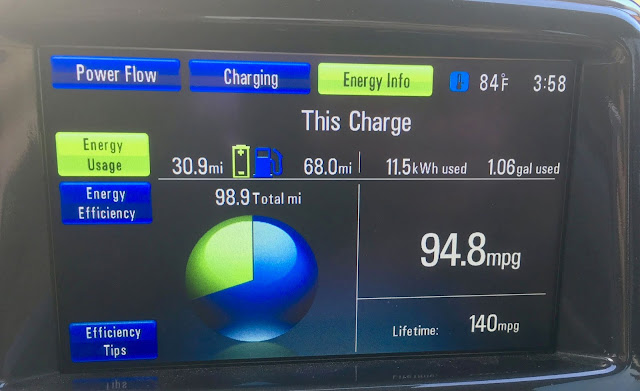
I've driven plenty of vehicles in the mountains - cars, motorcycles... well, mostly motorcycles. But they all are a lot of work to drive. Lots of shifting, braking, etc, and with cars, there's often some excitement as you go around corners.
The Volt is actually really boring in the mountains - but in a good way. If you put it in "L" mode, it's possible to single pedal drive the car for the most part. All the way off the gas is pretty aggressive deceleration, and otherwise it works as normal. You can just play with one pedal and zip around with the fury of electric torque (at low speed - the car is somewhat gutless at higher speeds). Plus, with all the weight down low from the battery, the car simply doesn't exhibit much body roll. It just corners.
Coming down mountain grades is also fun. Instead of having to worry about downshifting, maintaining one's brake temperatures, and the other (well, admittedly fun) aspects of mountain grades, I was just putting it in L, setting cruise control, and heading on down. Regen more than covered the energy from gravity, and stored it away for later use!
Reasons Not to Buy a Volt
I've been talking up the Volt for a while - and I really do think it's a great car, for almost everyone. But there are several use cases where it's simply not a good option.
The first is if you can never charge it (or can only rarely charge it). Yes, it'll behave like a hybrid and get tolerable fuel economy - but if you don't have a regular place to charge (at home or at work), you'll just burn more gas than a hybrid designed for that operating mode. A Prius manages north of 50mpg without being charged, and the Volt almost certainly won't get past 40. You won't damage the car not charging it - but it's really not how it's designed to be operated, and you'll miss the best parts of it.
The other use case it's not ideal for is really high daily miles. If you're a traveling salesman and do long days, the Volt isn't a great option. For long highway miles, you're (again) better with a Prius type hybrid. Or, if you're doing something on major highways, a long range pure battery electric might make sense. They're quite a bit cheaper to run, and DC fast charging (both Tesla and otherwise) is common enough that you can make most trips without too many detours.
Reasons to Buy a Volt
However: For the rest of us who do regular daily trips in the sub-30 mile range (if you're a bit over, get a Gen 2) and take the occasional longer trip - you really should consider a Volt.
It covers the common case on cheap electricity (if you live in CA with $0.25/kWh power, sorry - charge at night), and you can still drive across the country with the current gasoline-based infrastructure. It's two cars in one - an EV commuter, and a gas powered long range traveling vehicle. No, it's not quite as efficient as other long range options, but if long trips are a fraction of your total driving, the blend works out very, very well.
You can find a used Gen 1 for $8k-$10k these days, and a Gen 2 should be down around $15k for a reasonable one. Shop around, of course, but they're not that expensive - and they are a lot cheaper to run than a gas car, with much less uncertainty in fuel costs.
The long term reliability is pretty solid (look for a 2013 or later to avoid some stator bearing issues that require a bit of work to fix around 100k miles), and pack degradation is simply not a concern on these cars. The battery is never fully charged, it's very well thermally managed, and there's buffer on either side to stretch into if needed. Even if you do lose a bit of battery range, all it does is slightly increase the gas use - it doesn't make the car unusable for your driving, like losing range on a pure EV would.
PS: Install a Cabin Air Filter
A dirty little secret of the Gen 1 Volts (and possibly the Gen 2s - not sure, but I can't help with those) is that they didn't come from the factory with a cabin air filter. Supposedly it helps reduce the energy required for the climate control, but the difference is tiny. Put a cabin air filter in - and I'd suggest getting one that has the activated charcoal or carbon to help absorb smells. There are cases where the Volt can burn off some road debris if the engine hasn't run in a while, and it's got an odor. Or, say, if you're following a line of old cars that smoke under certain conditions, one might have been nice.
Adding a cabin air filter is quite easy - the access is through the glove box. You can find videos on the usual suspects, or just follow this quick guide.
With all the stuff out of the glove box, there should be a rubber mat on the bottom. Remove it.

Towards the top of the rear, there's a little finger grip - you can look for it, or just feel for it. Pull it. The rear and bottom of the glovebox now lift out.

You'll now see this - the cover for the air filter. Why does one go through the glove box for the air filter? I have no idea, but it's actually less annoying than on a lot of other vehicles.
There are two clasps on the side and one on the top. Some guides suggest using a small screwdriver to pop them, but they're not exactly stiff - you should be able to pop it by hand unless you have huge hands. Pop the top one first, then gently work the sides out, and you should see either an air filter or a huge gap!
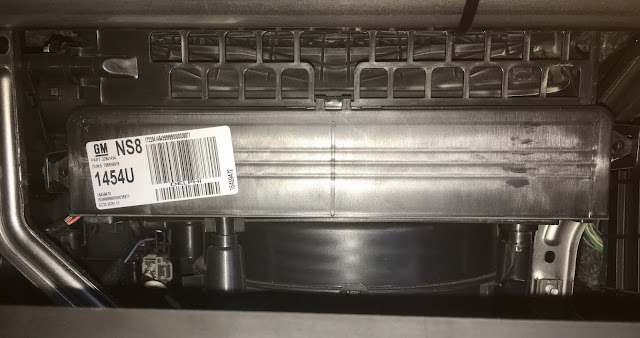
Replace the filter (arrow pointing down, according to legend - I didn't verify airflow direction), close things back up, and enjoy the somewhat quieter and, hopefully, somewhat less smelly air!

Why a Volt? It Fits Our Needs.
I'd originally planned on getting a used Leaf out of Seattle or Portland and keeping the Mazda 3 we had. However, paying attention to driving miles indicated that we'd be putting quite a few miles on the Mazda 3 - just days where things wouldn't fit in the Leaf's range profile (an older Leaf, not the new 200+ mile ones - those are expensive). Even with fast charging, the total lack of useful charging infrastructure out here just limits what moderate range EVs can do. We would either be putting a ton of miles on the truck (which rapidly eats up the savings of an EV), or we'd have to keep another car around.
A long range BEV would work - but they're quite expensive. One annoyance of mine is that no sales person around here bothers asking how much one pays in federal taxes before asserting that the actual cost is $7500 less than the actual price - and I don't know many people paying $7500/yr in federal income tax out here. Yes, you can create "taxable events" with IRA conversion and the like (if your finances line up to let you do that), but don't tell me a $40k car is $32,500 without asking questions first, because it's not.
My views on Teslas haven't changed over the past few years. They're not a car I can work on. A car I own free and clear, that I can't access the full diagnostics on, is simply not something I'll consider. Tesla could change this by opening up their service software and giving owners the ability to get at the diagnostics, but until they do that? Hard pass, sorry.
Or... we could get something that covers the common case on electric (most of our miles), still can do a long trip on gas (rare, but happens often enough that it's worth considering), and get the Volt.
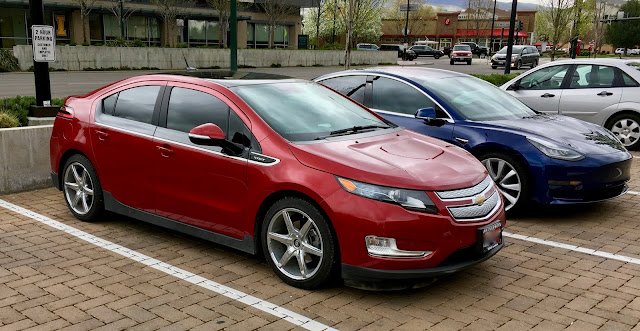
I can get parts, I can work on it, and I can (with the right hardware) access the dealer diagnostic interfaces. I can even flash the firmware on it myself, as the software to talk to the car is available for subscription access. It's not quite as open as I'd like, but for our needs? It's the best option out there.
Consider one!
I give myself permission to use my work in this way.
For those who don't live in a place where a short range BEV is a valid option - consider a used Volt! It can do everything, though if you don't have any charging capability, don't buy a Volt.
=============
Some while back, I tossed in a (little noticed) comment at the end of a post that we'd obtained a Chevy Volt. We picked up a used 2012 Volt with under 30k miles, and have been using it quite a bit, because, well, it's our car.

Since it's my blog and I can post what I want, I've decided to talk about the Volt for a while. I think it's the "sweet spot" for electric transportation at this point in time, I think it's rather significantly more environmentally friendly than a pure BEV for most use cases, and I think that, for most people, it's a really, really good car and highly worth considering if you're interested in cheap, (slightly) environmentally friendly car transportation. Plus, they depreciate like mad (just like all other electric cars), so you can get one cheaper than you might think!
The Chevy Volt
If you're not familiar with the Volt, you may be in the process of confusing it with the Bolt - which is also a Chevy product. And some marketing people at Chevy should be strung up for that bit of cutesy confusion, because it doesn't help anyone. It's confusion for the sake of confusion as far as I'm concerned.
The Bolt is a pure electric car (EV). The Volt, on the other hand, is a "plug in hybrid," a "series hybrid," a "range extended electric vehicle," or... probably half a dozen terms I've seen over the years. It's somewhere between a pure electric car and a hybrid - but, in reality, it's far better than either!
The Gen 1 Volt (2011-2015) has a 30-40 mile battery only range in the summer - plus a decent little gasoline engine and a useful gas tank (9 gallons) that can run it down the highway pretty much as long as you can find a gas station every few hundred miles. The Gen 2 (2016-2019) upgrades to about a 50 mile battery only range, a larger gas engine, and a different transmission design, but works out to the same thing - some battery range and then a gasoline engine for longer travel.

This means that you plug the car in at night (or during the day) to charge the main battery. When you set off, you run in a pure electric mode for the battery range - 20-60 miles, depending on which version you have and the outside temperature. Once the battery runs out, the gas motor kicks on, and you can drive it across the country on gas. Or, more commonly, make it home without having to find somewhere to charge.
But, on the flip side, it uses a far smaller battery pack than pure battery electrics - and it makes far better use of that pack!
BEV, PHEV, Hybrid, ICE... Oh My!
If you're familiar with electric vehicles, hybrids, and such, you can just skip this section.
If not, I'll explain a few of the various terms in common use you might run across, and what they mean.
We'll start with what everyone is familiar with: ICE. That means "Internal Combustion Engine." It refers to pretty much every vehicle that doesn't have a battery pack for propulsion (a "traction battery"). The phrase "Getting ICE'd" does not mean getting killed, in the context of electric vehicles. It means someone with a non-electric vehicle parking in a charging station. Don't do that.
Presumably, if you're the type of person who thinks a steam car is genuinely cool, you might hear the term ECE - External Combustion Engine. As someone who thinks steam cars are awesome and yet doesn't own one, well... I've not actually run across this term. But you might!
A "Hybrid" is a car that uses both a gasoline engine and a battery pack for propulsion - and doesn't allow you a way to recharge that pack (from the factory - I know people have added external charges to some of them). The Honda Insight and Toyota Prius are the most commonly seen versions of this sort of vehicle. When you decelerate, the car can recover the kinetic energy into a battery pack, and can use that energy to accelerate away from a stoplight. It improves fuel economy, and the Prius, in particular, uses some creative valve timing on the gasoline engine to improve efficiency more, at the cost of power production. A typical hybrid has a battery pack in the 1kWh range. It's not designed to propel the car down the road for long, just to store braking energy and use it for acceleration (though some will allow use for a bit of low speed driving).

Beyond that, you have PHEVs - Plugin Hybrid Electric Vehicles. The Volt sits in this category, as do things like the BMW i3 with the range extender, the Chrysler Pacifica minivan, the Prius Prime, and scattered other vehicles. This is similar to a hybrid, except that it has a far larger battery pack - and, importantly, a charge port. Most PHEVs have a battery pack in the 10-15kWh range, which means they can drive 30-50 miles on battery. Beyond that, there's a gasoline engine that kicks in and allows you to drive until the gas tank is empty. Details vary wildly - the BMW i3 has a tiny little peanut gas tank and a scooter engine for the range extender. The Gen 1 Volt has a smaller gasoline engine than the electric motor, which means mountains can be tricky (if you don't use "mountain mode" for hard climbs). The Gen 2 Volt has a large enough gas engine to run the whole vehicle on gas. The plug in Prius is similar. And, for what it's worth, I'd consider electric bikes to fit in here as well - you can still ride with the pedals if the battery pack is drained!
Finally, at the far end, you have BEVs - Battery Electric Vehicles, or just EVs. There's no gas motor anywhere in these cars. Just a large battery pack, an electric motor, and... well, that's it. If you're out of battery pack charge, push. Or hope you're on a mountain top and can use regenerative braking on the way down. This includes all the Teslas, the Nissan Leaf, the Chevy Bolt, and quite a few others.
Average Daily Driving Distances
At this point, I'm going to delve off into the weeds of statistics - and if your first thought isn't "How to lie and cheat with..." - well, let's just say that most statistics are calculated for a purpose.
Here, I'm going to quote an AAA study - "On average, Americans drive 29.2 miles per day, making two trips with an average total duration of 46 minutes." This is, of course, an average, and averages are mostly worthless, but it scopes the problem somewhat. The Office of Highway Policy Information has some data from 2009 (a bit dated, but still useful) that shows trip mileage and total miles driven by trip length.
While the vast majority of trips (by trip start count) are short, if you look at the mileage by trip length, the total mileage pie is more evenly split. This makes sense - longer trips, sort of by definition, chew up more miles than shorter trips!
Also, you should be horrified that 10% of car trips are less than 1 mile. Walk! Bike!


But the reality is that long distance driving is the minority of trips for most people. People still make long trips (greater than 50 miles is 3% of trip starts), and it's a use case that has to be handled, but it's not the typical daily trip for most people.
The "common case" is a short trip (less than 20 miles) - and the Volt handles those perfectly on electric.
Battery Packs, Embodied Energy, and Longevity
There is no battery fairy that waves a magic wand and blinks batteries into existence. Batteries require raw materials and quite a bit of energy to produce, and those have to come from somewhere. Lithium batteries, in particular, take a lot of energy to produce, and battery production is still quite limited globally (compared to global energy use, or even transportation energy use). This means we should be using batteries as efficiently as possible (while production constrained - and, I'd argue, for the long term as well to improve resource utilization) - and long range BEVs don't do that at all.
If you assume that people want one car to cover all their needs (from driving to the store next door, apparently, to driving across the country), that car needs a long useful range. For a gas powered car, this is no problem - we have a network of liquid fuel stations to refill from. For a battery powered car, making this work requires a rather large battery pack, and a network of fast charging stations. Tesla covers this use case decently (depending on where you want to go), but it means their cars have far more battery than is needed for most daily trips. A 100kWh Tesla can drive over 300 miles on a charge. When average daily driving trips are only 30 miles, this means the car has 10x the battery required for regular daily trips. I did some math a few years ago and estimated that the energy to produce a Tesla battery (before you ever use it) would power about a lifetime of electric bike use (https://syonyk.blogspot.com/2015/11/how-far-can-you-ride-electric-bike-on.html). The numbers are almost certainly better now, but there's still a lot of energy that goes into building battery packs that don't get heavily utilized.
Another concern is battery longevity. Cell phone batteries die inside a few years - why don't car batteries do the same? With a few exceptions (the Leaf's air cooled pack), EVs do a great job of managing their battery pack. They keep them cool in the summer, warm in the winter, and don't charge them fully. Not fully charging a cell really helps improve the longevity, and the data from most (not-Leaf) EVs shows that range loss just isn't that large a problem.
But what happens if you pick a far less battery intensive solution? That's what Chevy did, and it works really, really well!
Smaller Packs With a Backup
What Chevy has done in the Volt is to use a smaller pack (16kWh in the Gen 1), take good care of it, and use the middle 85% or so. The Volt pack is never fully charged according to the cell chemistry. It doesn't charge past 384V for the 96S pack, or 4.00 V/cell. You can pull 10-11kWh out of the Gen 1 pack before it's "empty" according to the car, but there's still a few kWh left at the bottom. The Volt uses this capacity to help with acceleration, to allow the engine to shut down at stoplights, and generally acts like a standard hybrid, even with "zero" battery range left.

If you do the math, the cells that would go into a single 100kWh Tesla can build over 5 Volt packs. Those packs can be run conservatively for an incredibly long life, and those cells will offset far, far more gasoline use in 5 Volt-type vehicles than they would in a single long range EV.
Yes, you run out of battery range more regularly, but since there's a gas engine that kicks in, it just doesn't matter. The transition in the Volt is seamless, and if it weren't for the dashboard showing that the mode had switched, I wouldn't know most of the time.
If you assume 5 Volts can do 30 miles a day on battery, that's 150 miles of electric range from those cars - every single day. Putting them all in one car (as you would with a long range BEV) would only replace a small fraction of that gas use (for most people). They're just carrying the cells for those occasional long distance drives that the Volt uses gas for.
Plus, with a normal EV, people never run the pack to empty. The car would stop moving if you do that. With the Volt? Running it "to empty" is just a normal part of operation, and the motor takes over to get you home. So you can regularly use that 10kWh of capacity and not worry about range - there is no concept of range anxiety.
"Empty" (no EV range remaining) works out to around 329V for the pack - or about 3.4V/cell. There's a bit of capacity left that the pack might use for various reasons, but the Volt really is gentle on the cells. A normal lithium cycle would be 4.2V fully charged to about 2.5V empty (or 3.0V if you care about longevity at least a tiny bit). The Volt cycles the cells from 4.0V to 3.4V - and that's squarely in the middle of their range, so they're not stressed at either end. It's an insanely conservative solution, but the pack longevity isn't a problem at all! Plus, the pack is thermally managed. Even on a 95F day, the pack is 78F when getting home. It's heated in the winter, cooled in the summer, and doesn't see extreme temperatures. The car will use energy to heat/cool the pack when plugged in, so keeping the car plugged in whenever possible helps longevity as well.

Numbers: A Year of Efficiency
As much as it might surprise people, I'm not keeping detailed statistics on the Volt. I don't like cloud services, so I'm not using the OnStar service (which is going away soon anyway - the Volt's cell modem only talks to towers that are getting shut down), and I haven't bothered to put local logging in. It's mostly my wife's car, and knowing detailed numbers doesn't really change anything - it's going to operate how it operates, and I'm not about to ask her to do things like turn the heat off (with kids in the back) to save a nickel in fuel on a trip.
We got the Volt to cover our common case trips on battery. They're typically 20-30 miles a day, round trip, into one of the nearby towns. We might do this multiple times on some days, but frequently it's one major trip. This is mostly on 45-55mph rural roads in a grid.
We've found that the Volt gets a pretty reliable 35 miles of battery range in the warmer weather. The air conditioning doesn't really impact the range a noticeable amount for our driving. However, in the winter, the battery range is far worse - sometimes as low as 20 miles. The whole car gets far less efficient in the winter (gas cars do as well, you just don't typically notice), and the car will use a ton of energy to heat both the car and the battery pack. If you've been driving long enough, things warm up, but that takes a lot of energy - and so the gas motor turns a lot more in the winter.
Of course, you can do better in certain conditions. If you're, say, following a bunch of antique cars around at 30-35mph, without HVAC, and there's a bit of a downgrade at the start of the trip, my personal best in a Gen 1 Volt is 53.3 miles on battery.

If it's cold enough, the Volt will run the gas engine for cabin heat. The car will get some electrical energy out of this, but mostly, the goal is hot coolant to cycle to the heater core. There are hacks to bypass this behavior, but for our driving distances, we'll use the engine at some point on a town trip in the winter, so I haven't bothered bypassing it.
On battery, the Volt will get 2-3.5 mi/kWh - you can get it slightly higher, but not by much (and it typically involves descending terrain). On the gas motor, fuel economy, warmed up, on the highway... is about 33mpg. I know it's rated higher, but this is what we get on standard E10 premium with a warmed up engine, doing 75mph (in other words, refueling during a highway run). Gas miles are consistently in the 30-35mpg range for any length travel, though they're worse in the winter when the engine block is cold.

It's not great - but it's also not terrible for a good sized four door car loaded down with four people and luggage, running on pure gas. Yeah, a Prius will do better - but running purely on gas is not at all the intended use case for a Volt!
More typically, we see 300-400 miles per gallon of gas used (in the warmer weather). The gas is used for days with multiple trips into town that exceed our charging capability, and for longer round trips (some of the places we go on occasion are 50-60 miles around - that's a gas day). Even on the longer trips, though, it's rare to drop below 70-80 miles per gallon of gas used - the 35 miles on electric really help bring the total up.

Charging: Yeah, 120V is Fine!
All of these numbers above? They're charging on 120V. It takes us 9-10 hours to charge the car from empty, and that means that mid-day charging almost never makes up the total used. If the car makes an early morning trip, it might be charged by the afternoon, but typically? Our evening trips start out half-charged. Sometimes I can top off in town, usually not.
I'll eventually add 240V charging to the property, but for nearly the last year, we've charged on 120V - and it still works fine. Even on nights when the car comes back late, it's still charged by the morning. If I had 240V charging, the car would be charged from empty in a hair over 3 hours - which would mean our evening trips were always starting with full battery. That would offset a good bit of our gas use - especially in the winter, when the battery spends a lot of energy producing heat.
One downside of 120V charging is that the preheat mode (when you suggest to the car that it might want to warm up with grid power) doesn't really save much energy - most of the energy for heating the systems comes from the battery, and though the car can use 5kW heating, it only gets 1.4kW from the wall. A 240V charger will help a lot on that front.
Volting About the Mountains: Antique Car Meets
I've talked about antique cars in the past (https://syonyk.blogspot.com/2017/09/driving-1927-willys-knight.html). This year, we went to a meet, but took the Volt. It's not antique, but it is well suited to hauling a 1 year old boy around - several experiments demonstrated that he wasn't able to sit by himself in the back of an older car, and that he wasn't at all happy with his car seat back there. We'll try again for an old car next year - but this year, I got a chance to run around some back roads and mountains around Pendleton with the Volt. It's the first time I've had a chance to really play around with the car in the mountains and on twisty roads - and it's an awful lot of fun!
One of the things you might run into (that drives some Volt owners nuts) is that the Volt's accounting of power to battery vs gas motor can feel a bit inaccurate at times. The car is either in battery mode or gas engine mode - and it won't swap back from the gas mode until the battery is sufficiently charged. Even if you charge for an hour or so on 120V during a trip, the car will still consider things in gas mode - even as it runs off the stored charge.
For this particular day, we started off by heading up a winding mountain road, then driving around up on top. The battery range is fairly poor because it was a hard climb up - but I was able to charge up on top. Even though the car never switched back from gas mode to electric mode, I got an extra kWh shown in the battery power used statistic. Then, coming down the mountain, I was able to regenerate about 2kWh into the pack (I had to check with a separate monitoring device - the car won't show this), and run around at the bottom of the mountain purely on electrons - even in "gas" mode.
This worked out to a gas "miles per gallon" of 64mpg - even though the car gets nowhere near this in reality. It's just a quirk of how the accounting system keeps track of things. Again, some people get annoyed by this, and I just don't care, because it's busy not using gas (and I'm not really keeping track of the statistics anyway). For normal driving, it's quite reasonable.

I've driven plenty of vehicles in the mountains - cars, motorcycles... well, mostly motorcycles. But they all are a lot of work to drive. Lots of shifting, braking, etc, and with cars, there's often some excitement as you go around corners.
The Volt is actually really boring in the mountains - but in a good way. If you put it in "L" mode, it's possible to single pedal drive the car for the most part. All the way off the gas is pretty aggressive deceleration, and otherwise it works as normal. You can just play with one pedal and zip around with the fury of electric torque (at low speed - the car is somewhat gutless at higher speeds). Plus, with all the weight down low from the battery, the car simply doesn't exhibit much body roll. It just corners.
Coming down mountain grades is also fun. Instead of having to worry about downshifting, maintaining one's brake temperatures, and the other (well, admittedly fun) aspects of mountain grades, I was just putting it in L, setting cruise control, and heading on down. Regen more than covered the energy from gravity, and stored it away for later use!
Reasons Not to Buy a Volt
I've been talking up the Volt for a while - and I really do think it's a great car, for almost everyone. But there are several use cases where it's simply not a good option.
The first is if you can never charge it (or can only rarely charge it). Yes, it'll behave like a hybrid and get tolerable fuel economy - but if you don't have a regular place to charge (at home or at work), you'll just burn more gas than a hybrid designed for that operating mode. A Prius manages north of 50mpg without being charged, and the Volt almost certainly won't get past 40. You won't damage the car not charging it - but it's really not how it's designed to be operated, and you'll miss the best parts of it.
The other use case it's not ideal for is really high daily miles. If you're a traveling salesman and do long days, the Volt isn't a great option. For long highway miles, you're (again) better with a Prius type hybrid. Or, if you're doing something on major highways, a long range pure battery electric might make sense. They're quite a bit cheaper to run, and DC fast charging (both Tesla and otherwise) is common enough that you can make most trips without too many detours.
Reasons to Buy a Volt
However: For the rest of us who do regular daily trips in the sub-30 mile range (if you're a bit over, get a Gen 2) and take the occasional longer trip - you really should consider a Volt.
It covers the common case on cheap electricity (if you live in CA with $0.25/kWh power, sorry - charge at night), and you can still drive across the country with the current gasoline-based infrastructure. It's two cars in one - an EV commuter, and a gas powered long range traveling vehicle. No, it's not quite as efficient as other long range options, but if long trips are a fraction of your total driving, the blend works out very, very well.
You can find a used Gen 1 for $8k-$10k these days, and a Gen 2 should be down around $15k for a reasonable one. Shop around, of course, but they're not that expensive - and they are a lot cheaper to run than a gas car, with much less uncertainty in fuel costs.
The long term reliability is pretty solid (look for a 2013 or later to avoid some stator bearing issues that require a bit of work to fix around 100k miles), and pack degradation is simply not a concern on these cars. The battery is never fully charged, it's very well thermally managed, and there's buffer on either side to stretch into if needed. Even if you do lose a bit of battery range, all it does is slightly increase the gas use - it doesn't make the car unusable for your driving, like losing range on a pure EV would.
PS: Install a Cabin Air Filter
A dirty little secret of the Gen 1 Volts (and possibly the Gen 2s - not sure, but I can't help with those) is that they didn't come from the factory with a cabin air filter. Supposedly it helps reduce the energy required for the climate control, but the difference is tiny. Put a cabin air filter in - and I'd suggest getting one that has the activated charcoal or carbon to help absorb smells. There are cases where the Volt can burn off some road debris if the engine hasn't run in a while, and it's got an odor. Or, say, if you're following a line of old cars that smoke under certain conditions, one might have been nice.
Adding a cabin air filter is quite easy - the access is through the glove box. You can find videos on the usual suspects, or just follow this quick guide.
With all the stuff out of the glove box, there should be a rubber mat on the bottom. Remove it.

Towards the top of the rear, there's a little finger grip - you can look for it, or just feel for it. Pull it. The rear and bottom of the glovebox now lift out.

You'll now see this - the cover for the air filter. Why does one go through the glove box for the air filter? I have no idea, but it's actually less annoying than on a lot of other vehicles.
There are two clasps on the side and one on the top. Some guides suggest using a small screwdriver to pop them, but they're not exactly stiff - you should be able to pop it by hand unless you have huge hands. Pop the top one first, then gently work the sides out, and you should see either an air filter or a huge gap!

Replace the filter (arrow pointing down, according to legend - I didn't verify airflow direction), close things back up, and enjoy the somewhat quieter and, hopefully, somewhat less smelly air!

Why a Volt? It Fits Our Needs.
I'd originally planned on getting a used Leaf out of Seattle or Portland and keeping the Mazda 3 we had. However, paying attention to driving miles indicated that we'd be putting quite a few miles on the Mazda 3 - just days where things wouldn't fit in the Leaf's range profile (an older Leaf, not the new 200+ mile ones - those are expensive). Even with fast charging, the total lack of useful charging infrastructure out here just limits what moderate range EVs can do. We would either be putting a ton of miles on the truck (which rapidly eats up the savings of an EV), or we'd have to keep another car around.
A long range BEV would work - but they're quite expensive. One annoyance of mine is that no sales person around here bothers asking how much one pays in federal taxes before asserting that the actual cost is $7500 less than the actual price - and I don't know many people paying $7500/yr in federal income tax out here. Yes, you can create "taxable events" with IRA conversion and the like (if your finances line up to let you do that), but don't tell me a $40k car is $32,500 without asking questions first, because it's not.
My views on Teslas haven't changed over the past few years. They're not a car I can work on. A car I own free and clear, that I can't access the full diagnostics on, is simply not something I'll consider. Tesla could change this by opening up their service software and giving owners the ability to get at the diagnostics, but until they do that? Hard pass, sorry.
Or... we could get something that covers the common case on electric (most of our miles), still can do a long trip on gas (rare, but happens often enough that it's worth considering), and get the Volt.

I can get parts, I can work on it, and I can (with the right hardware) access the dealer diagnostic interfaces. I can even flash the firmware on it myself, as the software to talk to the car is available for subscription access. It's not quite as open as I'd like, but for our needs? It's the best option out there.
Consider one!

